The inauguration
of the much-awaited Namma Metro was finally completed on October 20,
2011. The first section of the Bangalore metro, was opened by Urban
Development Minister Kamal Nath on October 20. The 6·7 km elevated
'Reach 1' from Byappanahalli to Mahatma Gandhi Road forms the eastern
section of the 18·1 km east-west line, serving six stations.
The Metro
rail chugged into the IT hub of Bangalore Thursday, promising the
beginning of the end of the city's traffic woes and becoming a reality
almost 30 years after the idea was mooted. Bangalore Metro Rail Corporation
Ltd. (BMRCL) expects an estimated 30,000 people to hop on the Reach
1 journey between Byappanahalli and M.G. Road every day.
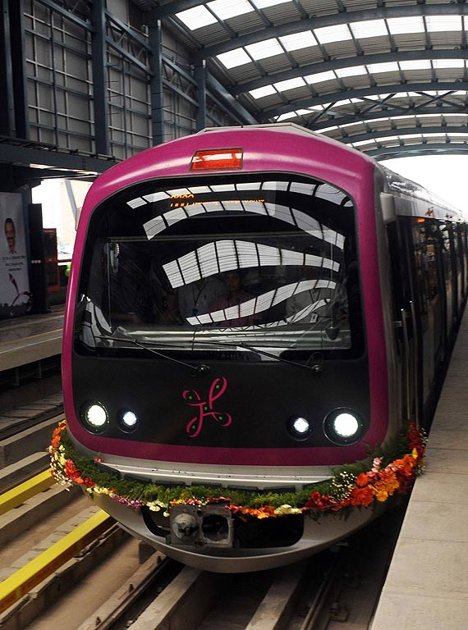 The
Bangalore Metro seems to be literally and metaphorically bringing
together the citizens of the country's Garden City.
The
Bangalore Metro seems to be literally and metaphorically bringing
together the citizens of the country's Garden City.
Media
reports talk of the Bangalore Metro evoking an unprecedented response
of smiles and waves on its inaugural run from children on playgrounds,
policemen on duty and homemakers hanging clothes on terraces, with
the passengers chanting 'Bharat Mata ki Jai', 'Jai Karnataka' and
'Jai Namma Metro', all reminiscent of the first flush of patriotism
in the early decades after Independence. According to Metro officials,
over 1 crore commuters have used the Metro services in the past three
days. Witnessing an overwhelming response on the first couple of days,
the Bangalore Metro Rail Corporation Limited (BMRCL) has decided to
run trains till 11.30 pm.
The dictionary
may define a metro as an underground railway a la the Paris subway,
but the one in Bangalore literally reaches for the sky while passing
over lush green stretches. The Bangalore Metro has been described
as world-class, with the first train being run by driver Sowjanya,
almost as if to make the point that what a man can do, a woman can
do much better.
The next
stage will include a 4·9 km underground section through the
city centre from MG Road to the main station, adding four more stops.
From here the line will return to viaduct for the 6·5 km Reach
2, which will serve five intermediate stations before terminating
at Mysore Road on the western side of the city.
BMRC
is also developing a 24 km north-south route from Yeshwanthpur to
RV Road, with 21 stations. This line will have a 3 km underground
section with three stations in the city centre, including an interchange
with the east-west line at the railway station.
Longer-term
plans include a northern extension from Yeshwanthpur to Hesargatta
Cross in the northwest and a southern extension from RV Road to Puttenhalli
Cross. This would add another 66·9 route-km, with all four
radial routes extended further into the surrounding suburbs.
Interior
of the Train
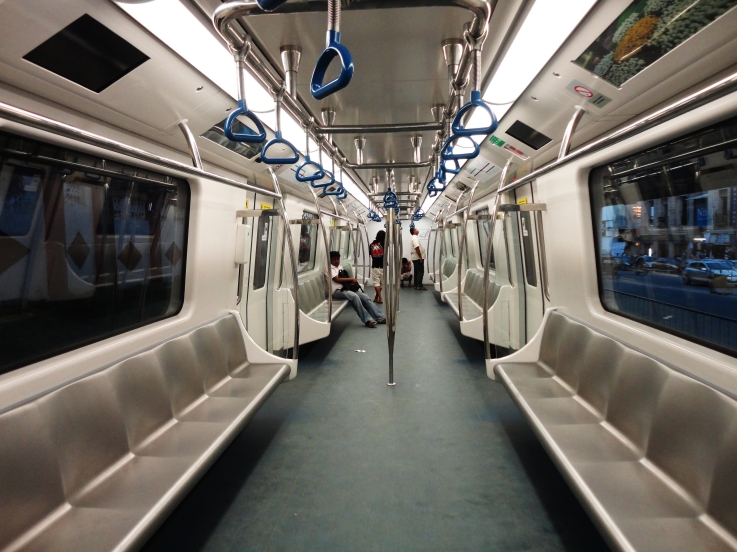
Source : tsr.net.co- Pic by Anusha V Iyer
FARES
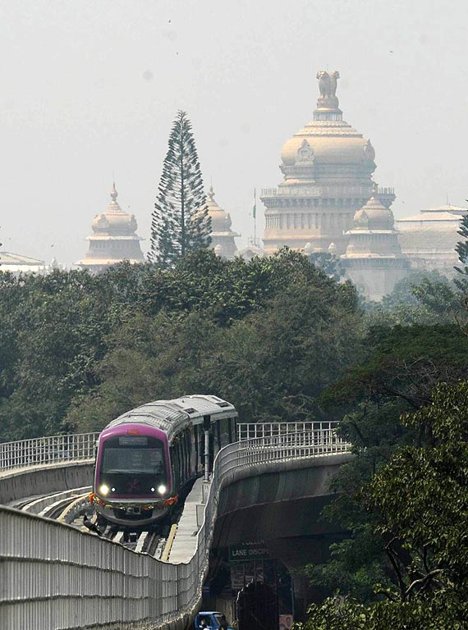 The
fares for travel by Namma Metro Reach 1, between Byappanahalli and
M.G. Road that has six stations, have been finalised.
The
fares for travel by Namma Metro Reach 1, between Byappanahalli and
M.G. Road that has six stations, have been finalised.
Commuters
will have to pay a minimum of Rs. 10 and a maximum of Rs. 15 for their
journey on the stretch. Also the Namma Metro Travel Cards can be purchased
online.
According
to the Board Sub Committee of Bangalore Metro Rail Corporation Ltd.
(BMRCL), which finalised the fares, the commute from Byappanahalli
to Swami Vivekananda Road is Rs. 10, to Indiranagar Rs. 12, to Ulsoor
Rs. 12, to Trinity Circle Rs. 14 and M.G. Road Rs. 15.
In the
return direction, the fares from M.G. Road will be Rs. 10 to Trinity
Circle, Rs. 12 to Ulsoor, Rs. 12 to Indiranagar, Rs. 14 to Swami Vivekananda
Road and Rs. 15 to Byappanahalli.
While
the minimum fare, for a distance of 1 km, is Rs. 10, the maximum fare
that is between Byappanahalli and M.G. Road for a distance of 6.7
km, is Rs. 15.
The committee
has recommended introduction of stored value tickets, group tickets
and integrated metro-bus tickets as well.
Smart
cards
Except
for group tickets, which will be in the form of paper ticket and Contactless
Smart Tokens for single journey, tickets for multiple journeys have
to be bought in the form of Contactless Smart Cards (CSC).
CSCs
offer discounted fares for passengers and come in two kinds —
Varshik to perform multiple journeys between any station, and Sanchar
for fixed number of trips between two particular stations. Passengers
can buy the CSC at Rs. 50 and can load either Varshik or Sanchar or
both on it. For Varshik, a passenger can load maximum of Rs. 1,500
in multiples of Rs. 50; the CSC will be valid for one year from the
date of last “add value”. Apart from metro stations, values
can be added through ATMs, net banking and mobile banking of State
Bank of India; Bangalore Metro website and scratch cards through SMS.
Namma
Metro Travel Cards can be purchased online. Every card has a unique
11 digit number engraved on the rear face of card. You can now choose
your own premium number. The charges for premium numbers are dependent
upon the choice made for last 3 or 4 numbers, 5 or 6 numbers and 7
numbers. It is Rs. 50, Rs. 100 and Rs. 150 respectively.
Advantage
of buying Online : The owners of these premium number cards enjoy
privilege over others having normal number cards. You can give request
to block these cards online whenever the card is lost or stolen.
The user
has to register on this site and furnish required details. The selected
card after making online payment will be despatched at the address
furnished through post within 7 working days.
The
Route
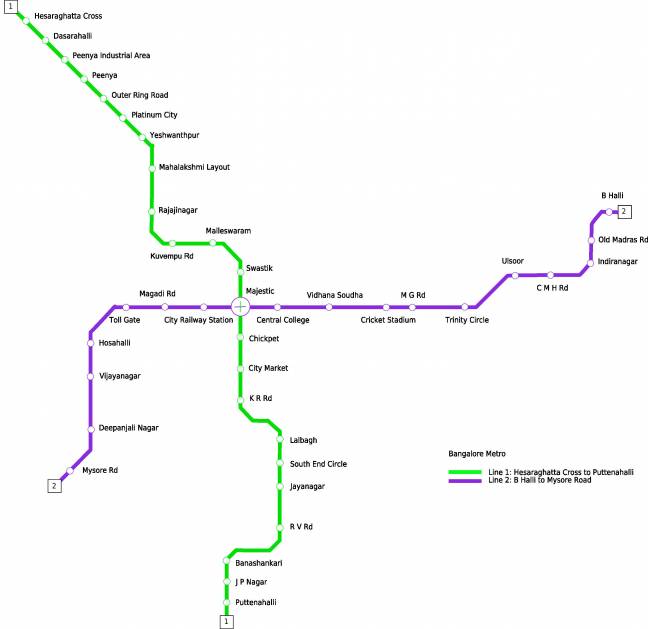
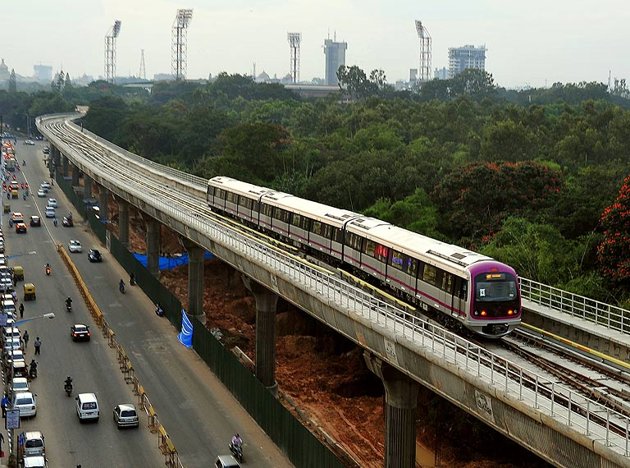
Discounted fares
Varshik
is designed to be cheaper than token cards. For example, you can travel
at a discounted Rs. 8.50 between Byappanahalli and S.V. Road and for
Rs. 12.75 between Byappanahalli and M.G. Road.
Sanchar
is more useful for regular commutes between two specific stations
for work as they are by 5 to 10 per cent cheaper than Varshik tickets.
Fare
zones
Fare
zones are classified by distance. For F1 Zone (0 to 2 km), a 10-trip
Sanchar will cost Rs. 80, 40-trip Rs. 316, 50-trip Rs. 395 and 100-trip
Rs. 765.
For F2
zone (2 to 4 km), the discounted fares are Rs. 95, Rs. 375, Rs. 470
and Rs. 920. For distance ranging between 4 and 6 km (F3), the Sanchar
fares are Rs. 115, Rs. 440, Rs. 550 and Rs. 1,070.
For F4
zone (6 to 7 km), that is between Byappanahalli and M.G. Road, the
Sanchar fares are Rs. 120 for 10 trips, Rs. 470 for 40 trips, Rs.
590 for 50 trips and Rs. 1,150 for 100 trips.
Group
tickets will be issued to a minimum 10 passengers travelling together
between the same set of stations and are 10 per cent cheaper than
token tickets.
Feeder
Buses
Even
as the Bangalore Metro Rail Corporation (BMRCL) is racing against
time to get Namma Metro ready for its formal inauguration on April
4, the BMTC has begun plying feeder buses on a few routes along Reach
1 stretch between MG Road and Byappanahalli. The BMTC, which has entered
into an arrangement with the BMRCL to run the feeder bus services
from the six ReachOne stations to nearby areas, is charging its usual
fares for the new services too.
Ten mini
buses are running on select feeder routes for now. All efforts have
been made to provide the Metro feeder bus services a unique branding.
The buses coated in silver hue, have a pink band in the middle.
In all,
26 feeder routes have been identified to run from the six ReachOne
stations. The BMTC has planned to deploy 64 buses on these routes
and 10 of these will be mini buses. The
mini buses currently on the feeder routes have been fabricated at
the BMTC’s Indiranagar depot. Fabrication work is on for the
remaining 54 big buses but they will run only after Metro becomes
operational.
Five
feeder routes each have been identified along Byappanahalli, Indiranagar,
Halasuru and MG Road, while four each have been identified along Trinity
Circle and Swami Vivekananda stations. The
feeder buses will run at a frequency of 10 minutes which will be later
increased to five minutes based on demand. The minimum ticket fare
will be Rs 5.
Integrated
daily pass
The BMTC
and BMRCL have also rolled out the common pass — Metro Bus Transit
(MBT) — which will be distributed in feeder buses services and
BMTC depots and pass counters. The
MBT is of two types — Saral and Saraag. While Saral MBT would
cost Rs110 and the commuter can travel in air-conditioned buses as
well as the Metro, the Saraag MBT is priced at `70 and will enable
commuter to travel in ordinary BMTC buses and the Metro.
The Rs110
pass has an insurance coverage of Rs5 lakh with a reimbursement facility
up to Rs50,000 in case of accidents. The Rs70 pass has an insurance
coverage of Rs1 lakh with reimbursement up to Rs20,000 in case of
accidents.


